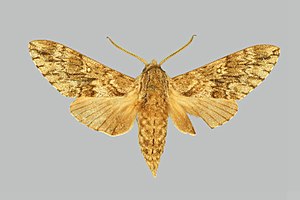Dolbina grisea
| Dolbina grisea | ||||||||||||
|---|---|---|---|---|---|---|---|---|---|---|---|---|

Dolbina grisea , male |
||||||||||||
| Systematics | ||||||||||||
|
||||||||||||
| Scientific name | ||||||||||||
| Dolbina grisea | ||||||||||||
| ( Hampson , 1893) |
Dolbina grisea is a butterfly ( moth ) from the family of moth (Sphingidae). Only a few specimens of this species have been caught so far, even if it is said to be not rare in eastern Afghanistan. Very few females have been documentedfor light catches .
features
The moths have a wingspan of 50 to 64 millimeters. They have white and gray patterned forewings, on which a white, dark-edged discal spot and a band in the post-discal region delimited by two fine, jagged dark bands. The hind wings are gray. Some animals from less temperature-favored areas or those that have experienced colder weather during their development have a darker color than usual.
The egg is spherical and measures two millimeters in diameter. It is pale green or blue-green in color.
The caterpillars are 43 to 56 millimeters long. Initially, the five to 12 millimeter long caterpillars are yellowish-green and have a two millimeter long, brown anal horn . They have two pale whitish lines on their backs and a rounded head. In the second stage, they are 12 to 15 millimeters long. They look very similar to the caterpillars of the poplar hawkmoth ( Laothoe populi ) and have an equally triangular head. The four millimeter long anal horn is yellowish green. The body, provided with fine tubercles, is pale green and has a conspicuous yellowish-white longitudinal line on both sides of the back, as well as seven oblique side stripes on the abdomen. In the third stage, the coloring is similar to the second. In the fourth stage, the body is apple-green and densely covered with fine yellow tubercles. The seven oblique lateral stripes are bold yellow, similar to the dorso-lateral longitudinal lines that extend from the head to the third abdominal segment. The triangular head is green with yellow cheeks. The belly bones are pink, the anal horn is greenish-yellow and has a green tip and fine yellow tubercles. In the fifth stage they are similarly colored, but the body is increasingly turning bluish-gray on the sides. In some individuals, the tubercles may be white instead of yellow. Before pupation, the animals turn brown.
The doll is 28 to 32 millimeters long. It is glossy dark brown and has reddish-brown abdominal segments. The 1.5 millimeter long Kremaster is cylindrical and ends in a double point.
Occurrence
The species is currently only known from northern Pakistan, Kashmir, eastern Afghanistan, Tajikistan, the west of the Hissar Mountains in southern Uzbekistan and the temperate foothills of the Himalayas in Himachal Pradesh in India. It inhabits temperate mountain forests, including juniper stands .
Way of life
The moths fly in early April and early June to August. Sometimes they also fly from late September to early October, depending on the altitude. The species probably trains two or three generations per year. The caterpillars on river ash ( Fraxinus potamophila ) have been identified from Tajikistan . The pupa hibernates. Parasitoids of the species are not yet known.
supporting documents
Individual evidence
literature
- Ian J. Kitching, Jean-Marie Cadiou: Hawkmoths of the World. An Annotated and Illustrated Revisionary Checklist (Lepidoptera: Sphingidae). Cornell University Press, New York 2000, ISBN 0-801-43734-2
